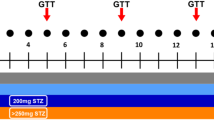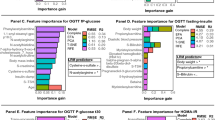Abstract
Objective:
We describe how a single intraperitoneal injection of an indoline-derived drug (SN 28127) reduced mouse body weight (25–45% loss) and adipose tissue mass (∼75%).
Methods and results:
The reductions in body weight peaked at ∼21–28 days post drug injection and were maintained throughout the study (160 days). The mice ate as much as vehicle-treated control mice. A more potent SN 28127 analog (SN 29220) reversed high-fat diet-induced obesity and type 2 diabetes in C57BL/6J mice on a high-fat diet. Insulin induced a sustained reduction in blood glucose in fasted SN 29220-treated mice compared with the vehicle-treated mice. All drug-treated mice exhibited a transient increase in water intake from ∼10 days post drug injection that lasted for ∼70 days. Following a single injection of 3H-labeled SN 29220, radioactivity accumulated within 4 h in the liver, bile duct and ileum with little detected in the brain; within 1–2 days, most of the radioactivity was found in the pancreas, spleen, liver, bile duct, stomach, kidneys and white adipose tissue. High levels of glucose were detected in urine collected from SN 29220 but not vehicle-treated C57BL/6J mice at ∼60 days post injection, while fecal triacylglycerols and cholesterol were not different between SN 29220 and vehicle-treated mice. These data lead us to hypothesize that the hepatic system is the primary drug target. Genes involved in fatty acid synthesis (FASn, SCD1 and PPARγ) and appetite stimulation (AGRP) were upregulated at 160 days post drug treatment, indicative of adaptation to reduced body weight.
Conclusion:
We hypothesize that indoline-derived drug-induced chronic toxicity to the hepatic system leads to a reduction in white adipose tissue mass. The mice adapt to this drug-induced toxicity with reduced steady-state body weight. Understanding molecular mechanisms underlying these responses has potential to identify novel targets for prevention and treatment of obesity.
This is a preview of subscription content, access via your institution
Access options
Subscribe to this journal
Receive 12 print issues and online access
$259.00 per year
only $21.58 per issue
Buy this article
- Purchase on SpringerLink
- Instant access to full article PDF
Prices may be subject to local taxes which are calculated during checkout







Similar content being viewed by others
References
Friedman JM . Obesity: causes and control of excess body fat. Nature 2009; 459: 340–342.
Lee J, Song KS, Kang J, Lee SH . New trends in medicinal chemistry approaches to antiobesity therapy. Curr Top Med Chem 2009; 9: 564–596.
Foster-Schubert KE, Cummings DE . Emerging therapeutic strategies for obesity. Endocr Rev 2006; 27: 779–793.
Curfman GD, Morrissey S, Drazen JM . Sibutramine--another flawed diet pill. N Engl J Med 2010; 363: 972–974.
Ledford H . Slim spoils for obesity drugs. Nature 2010; 468: 878.
Tercel M, Stevenson RJ, Lu GL, Stribbling SM, Wilson WR, Tatnell MA et al. Weight loss effects of quaternary salts of 5-amino-1-(chloromethyl)-1,2-dihydro-3H-benz[e]indoles; structure-activity relationships. Bioorg Med Chem 2012; 20: 734–749.
Duchesnes CE, Naggert JK, Tatnell MA, Beckman N, Marnane RN, Rodrigues JA et al. New Zealand Ginger mouse: novel model that associates the tyrp1b pigmentation gene locus with regulation of lean body mass. Physiol Genomics 2009; 37: 164–174.
Friedman JM, Halaas JL . Leptin and the regulation of body weight in mammals. Nature 1998; 395: 763–770.
Perez-Tilve D, Hofmann SM, Basford J, Nogueiras R, Pfluger PT, Patterson JT et al. Melanocortin signaling in the CNS directly regulates circulating cholesterol. Nat Neurosci 2010; 13: 877–882.
Wu D, Molofsky AB, Liang HE, Ricardo-Gonzalez RR, Jouihan HA, Bando JK et al. Eosinophils sustain adipose alternatively activated macrophages associated with glucose homeostasis. Science 2011; 332: 243–247.
Mebius RE, Kraal G . Structure and function of the spleen. Nat Rev Immunol 2005; 5: 606–616.
Bolzan AD, Bianchi MS . Genotoxicity of streptozotocin. Mutat Res 2002; 512: 121–134.
Szkudelski T . The mechanism of alloxan and streptozotocin action in B cells of the rat pancreas. Physiol Res 2001; 50: 537–546.
Chopra AR, Kommagani R, Saha P, Louet JF, Salazar C, Song J et al. Cellular energy depletion resets whole-body energy by promoting coactivator-mediated dietary fuel absorption. Cell Metab 2011; 13: 35–43.
Acknowledgements
We would like to thank Associate Professor C Print for analysis of the spleen histology, Mrs O Shevstova for help with tissue collection, processing and cutting tissues on the cryostat, Dr C-S Wu for help in setting up the real-time PCR, Dr B Pontré for help with the magnetic resonance imaging and Ms J Ross for help with image processing. We also thank Mrs Sarah Bould, Mrs Kristina Blagoeva-Hubbard and Dr Yongchuan Gu for technical help with the urinary glucose and fecal fat collection studies. The Marsden Fund (KGM, MT, WAD and WRW) and Auckland Uniservices (KGM, MT, WAD and WRW) provided funding for these studies.
Author information
Authors and Affiliations
Corresponding author
Ethics declarations
Competing interests
The authors declare no conflict of interest.
Additional information
Supplementary Information accompanies the paper on International Journal of Obesity website
Rights and permissions
About this article
Cite this article
Tercel, M., Marnane, R., Tatnell, M. et al. An indoline-derived compound that markedly reduces mouse body weight. Int J Obes 37, 685–692 (2013). https://doi.org/10.1038/ijo.2012.97
Received:
Revised:
Accepted:
Published:
Issue date:
DOI: https://doi.org/10.1038/ijo.2012.97



